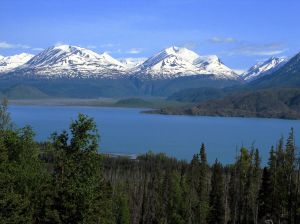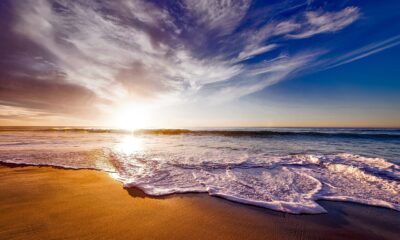

Economy
Sustainable holiday destinations: Alaska
Alaska is fast becoming a thriving holiday destination, captivating visitors with its pristine wilderness and wild adventures. Its plentiful natural capital makes it an ideal location for people to rediscover their relationship with wildlife and nature.
In terms of overall area, Alaska is the largest state in the US. It has the Arctic Ocean to the north and the Pacific Ocean to the south and west. Juneau is the state capital and the third largest city by population size behind Anchorage and Fairbanks.
Alaska is comprised of eight designated national parks, including distinguished preserves such as Wrangell-St Elias national park and Denali national park.
Wrangell-St Elias covers some of the St Elias Mountains and is part of an International Biosphere Reserve. Alongside other national parks like Glacier Bay, it forms a proportion of a UNESCO World Heritage Site – which contains the largest non-polar icefield in the world.
The Denali national park is home to Mount McKinley – the highest peak in North America, with the summit at over 20,000ft. One of Alaska’s most popular attractions, Denali attracts over 400,000 visitors annually. People flock to see its spectacular wildlife, such as the largest bears in the world – the brown bear – as well as other animals like mooses and wolves.
Visitors to Alaska can discover its pure wilderness through a variety of forms, from mountains hikes exploring many of the breathtaking mountain, glacier and lake location views, to outdoor backcountry treks and excursions along extensive trails and nature paths.
In the winter season, snow pursuits, sport and culture events rank highly as major motivations to visit. Iconic winter sport activities such as the official state sport of dog mushing, as well as snowboarding, skiing and snowshoeing, attract a significant amount of attention.
During the summer, ocean day cruises at destinations like Kenai Fjords provide passenger with a platform to watch whales and other aquatic wildlife. Seals, sea otters and puffins are commonly found in the open, as well as seeing the magnificent landscape and coast of Alaska. Furthermore you can experience a riverboat ride in the Alaska Interior aboard an authentic, grand sternwheeler. A range of sporting activities can be undertaken in rivers and across trails like kayaking, mountain biking, canoeing, rafting and angling.
The Alaska Railroad connects and transports passengers and freight services right across many of the state’s hard to reach places, since its inception in 1914. The railroad takes travellers on an adventure through spectacular Alaskan scenery, extending from Seward and Whittier in the south to Fairbanks and beyond. Routes and rail tours present the opportunity to visit the national parks by rail, and travel on the railroad’s flagship train, the Denali Star Train.
Two state-wide organisations have outlined responsible tourism practices as fundamental for stable tourism development in Alaska. Adventure Green Alaska is the state’s only tourism certification programme. Businesses have to reach and implement rigorous standards of environmental and social sustainability in order to become certified. Meanwhile, the Alaska Wilderness Recreation & Tourism Association (AWRTA) is a membership association representing ecotourism businesses in Alaska. As part of its ecotourism guidelines, businesses should seek to minimise their impact on the natural environment, as well as benefitting the local economy and communities directly.
Accommodation and local cuisine brings a whole new dimension to your stay in Alaska – from all-inclusive wilderness lodges and resorts, to rustic cabins, to more affordable options like campgrounds and hostels. Restaurants often offer locally sourced produce on their menus, as well as local beer. Set up by the State Division of Agriculture, the Alaska Grown programme and accompanying logo recognises brands that are grown locally, and raises awareness of Alaska grown products.
Despite its attractiveness as a holiday destination, there is a growing debate about whether holidaying in the polar regions such as Antarctica and glacial areas like Alaska and Iceland is a responsible thing to do. Concerns have been raised over unnecessary travel to these areas, with their mountain terrain vulnerable to excessive human activity. This can result in the loss of natural ecosystems and vibrant wildlife.
But sustainable and responsible tourism activity in regions like Alaska can certainly be beneficial in stimulating the local economy, enterprise and job creation. However, major tourism development must avoid or even reverse the effects of this form of activity on environmental degradation.
Alaska continues to develop as a sustainable holiday destination. Its commitment to sustainability will help prevent the rapid decline of vulnerable landscapes, and retain its inspiring glacial presence. It offers access to quality, beautiful and low impact travel to natural habitats and memorable sites.
What a state membership association says about Alaska
“Alaska is truly unique with its diverse land, ecosystems and cultures. Sustainable tourism is very important for our state. While we encourage tourism, we also abide by the regulations that preserve our natural resources and respect the Alaska native culture and lands.”
Jenni Pollard, President, Adventure Green Alaska
Further reading:
Sustainable holiday destinations: Kenya
Sustainable holiday destinations: Blue Mountains, New South Wales
Sustainable holiday destinations: Costa Rica
































